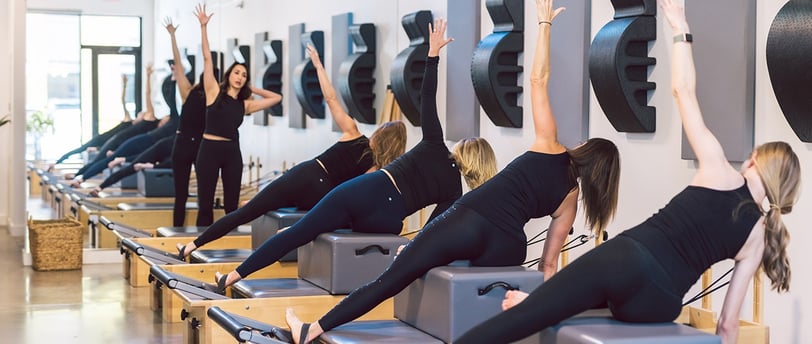welcome
Pilates vs. Yoga: Which is Right for You?
When it comes to fitness and wellness, Pilates and yoga are two popular practices that often come up in conversation. Both offer numerous benefits for the mind and body, but they have distinct philosophies, techniques, and outcomes. If you’re trying to decide which practice is right for you, this guide will help you understand the key differences and benefits of each.
12/3/20243 min read


When it comes to fitness and wellness, Pilates and yoga are two popular practices that often come up in conversation. Both offer numerous benefits for the mind and body, but they have distinct philosophies, techniques, and outcomes. If you’re trying to decide which practice is right for you, this guide will help you understand the key differences and benefits of each.
## Understanding Pilates
### What is Pilates?
Pilates is a physical fitness system developed by Joseph Pilates in the early 20th century. It focuses on core strength, flexibility, and overall body awareness through controlled movements. The method emphasizes precision, alignment, and breathing, making it an effective way to build strength and improve posture.
### Key Benefits of Pilates
- Core Strength: Pilates is renowned for its ability to strengthen the core muscles, which support the spine and improve overall stability.
- Improved Flexibility: The controlled movements promote flexibility in muscles and joints.
- Injury Rehabilitation: Many physical therapists use Pilates as a rehabilitation tool due to its low-impact nature and focus on alignment.
- Enhanced Posture: By strengthening the core and back muscles, Pilates helps improve posture and reduce back pain.
- Mind-Body Connection: Pilates encourages mindfulness through focused breathing and concentration on movements.
### Who Should Try Pilates?
Pilates is ideal for individuals looking to:
- Build core strength and stability.
- Improve posture and alignment.
- Recover from injuries or manage chronic pain.
- Engage in a structured workout that emphasizes precision.
## Understanding Yoga
### What is Yoga?
Yoga is an ancient practice that originated in India thousands of years ago. It encompasses physical postures (asanas), breath control (pranayama), meditation, and ethical principles. Yoga aims to create harmony between the mind, body, and spirit, promoting overall well-being.
### Key Benefits of Yoga
- Stress Reduction: Yoga is well-known for its ability to reduce stress and promote relaxation through mindful breathing and meditation.
- Increased Flexibility: Regular practice can significantly improve flexibility in both muscles and joints.
- Mental Clarity: The meditative aspects of yoga enhance mental clarity and focus while promoting emotional stability.
- Balance and Coordination: Many yoga poses require balance, helping to improve coordination over time.
- Holistic Health: Yoga promotes overall health by integrating physical fitness with mental wellness.
### Who Should Try Yoga?
Yoga is suitable for individuals looking to:
- Reduce stress and anxiety.
- Enhance flexibility and balance.
- Cultivate mindfulness and mental clarity.
- Explore a holistic approach to health that includes physical, mental, and spiritual elements.
## Key Differences Between Pilates and Yoga
### Focus
- Pilates primarily targets physical conditioning with a strong emphasis on core strength, muscle toning, and rehabilitation.
- Yoga encompasses a broader philosophy that includes physical postures, breath control, meditation, and ethical living.
### Movement Style
- Pilates involves controlled movements often performed on specialized equipment (like the Reformer) or mats. The exercises are typically more dynamic with a focus on muscle engagement.
- Yoga includes static poses held for longer durations along with flowing sequences (like vinyasa). The emphasis is on breathing deeply into each pose.
### Breathing Techniques
- In Pilates, breathing is coordinated with movement to enhance muscle engagement.
- In Yoga, breath control (pranayama) is a fundamental aspect that supports relaxation and mindfulness throughout the practice.
### Class Structure
- Pilates classes often focus on specific muscle groups or rehabilitation exercises with a structured format.
- Yoga classes can vary widely in style (Hatha, Vinyasa, Ashtanga, etc.) and may include elements of meditation or philosophy alongside physical practice.
## Making Your Choice
Choosing between Pilates and yoga ultimately depends on your personal fitness goals, preferences, and lifestyle. Here are some considerations:
### Choose Pilates If You:
- Want to specifically strengthen your core muscles.
- Are recovering from an injury or looking for rehabilitation exercises.
- Prefer a more structured workout focused on physical conditioning.
### Choose Yoga If You:
- Are looking for stress relief and mental clarity.
- Want to improve flexibility while also exploring mindfulness practices.
- Prefer a holistic approach that integrates mind-body-spirit wellness.
## Conclusion
Both Pilates and yoga offer unique benefits that can enhance your physical fitness and mental well-being. Whether you choose one over the other or decide to incorporate both into your routine, understanding their differences will empower you to make an informed decision that aligns with your health goals. Ultimately, the best practice is one that resonates with you personally—so why not try both? You may discover that each offers something valuable for your journey toward health and wellness!
